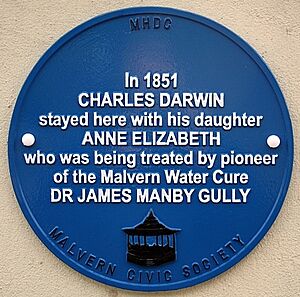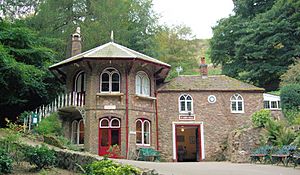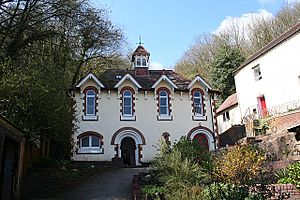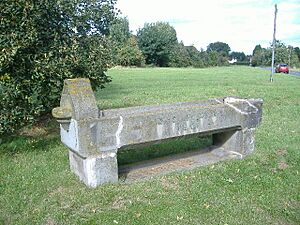Malvern water facts for kids
Malvern water is a special natural spring water that comes from the Malvern Hills. These hills are located on the border between Herefordshire and Worcestershire in England. The hills are made of very hard rock like granite and limestone. Rainwater slowly seeps through tiny cracks in these rocks. It then comes out at the springs, flowing at about 60 litres every minute! This flow has never stopped.
People have talked about the good things Malvern water can do for over 400 years. In the 1800s, Malvern became famous for its "water cure". This made the small village grow quickly into a busy town with many large hotels. Famous writers and patients, like Lord Lytton, helped make Malvern well-known. Malvern water has been bottled for sale since 1850 by Schweppes and later by a family company called Holywell Malvern Spring Water. Even British kings and queens have enjoyed it! Elizabeth I drank it in public, and Queen Victoria always took it with her when she traveled.
Contents
Why Malvern Water is So Pure
Malvern water has always been known for being very pure. In 1756, a doctor named Dr John Wall tested the water. He found it had very few minerals. He famously said, "The Malvern water is famous for containing just nothing at all...!" Another person, William Heberden, also said it was purer than any other spring water he had ever tested in England.
The natural water is usually free of minerals, bacteria, and tiny bits of dirt. It's almost as pure as distilled water. In 1987, Malvern water was officially recognized by the EU as a natural mineral water. This is a special sign of its purity and quality. However, in 2006, a dry spell made the water flow too fast through the rocks. This meant it wasn't filtered as well naturally. Because of this, the company bottling it had to add filters. This changed its official classification to "spring water" under EU law.
Where the Springs Are Found
There are about 70 places around the Malvern Hills where the water comes out. Local people often fill their containers for free at these spots. One famous place is the St Ann's Well in Great Malvern. It's inside a building that dates back to 1815. Some other popular places to find the water include:
- Beauchamp Fountain – on Cowleigh Road
- Enigma Fountain – in the town centre
- Evendine Spring – on Jubilee Drive
- Hayslad Spring – on West Malvern Road
- Holy Well – in Malvern Wells
- Jubilee Fountain – also in Malvern Wells
- Morris Well – in Lower Wyche
- St Ann's Well – in Great Malvern
The Walms Well is one of the oldest documented springs, dating back to about 250 BC.
Historical Uses of the Water
People have believed for a long time that Malvern spring water could help heal illnesses. There's an old poem from the 1600s that talks about how many people with "ulcers sore" and "bruises" found help from the water. It also mentions that "A thousand bottles here, were filled weekly."
In 1622, an eye doctor named Richard Banister wrote about the "Eye Well" near the Holy Well. He said it "helped sore eyes with a new found well."

In 1756, Dr. John Wall wrote a pamphlet praising Malvern water. This helped make the water even more famous. People started coming to Malvern just to drink the water and try to get better. The town became so popular that sometimes there weren't enough places for visitors to stay!
In 1842, two doctors, James Manby Gully and James Wilson, opened special "water cure clinics" in Malvern. This was the start of the town's growth and success. These clinics were the first of their kind in Britain. Many famous people came to Malvern for the water cure, including Charles Darwin (whose daughter is buried there), Florence Nightingale, and Lord Tennyson. Their visits helped spread the word about Malvern water even more.
How Malvern Water Was Sold
Malvern water has been bottled and sold in the UK and other countries for a very long time, even since the time of King James I. The Holy Well started bottling water in 1622.
In 1850, Schweppes began bottling Malvern water on a large scale. They opened a bottling plant at the Holywell in Malvern Wells. Schweppes first sold it as Malvern Soda, then Malvern Seltzer Water. In 1890, Schweppes moved their bottling plant to Colwall.
The Holywell plant was later used by other companies until the 1960s. It became unused until 2009. Then, with help from a special grant, a family-owned company started bottling water there again. They now produce 1200 bottles of Holywell Spring Water every day. This well is believed to be the oldest bottling plant in the world!
In 2010, Coca-Cola Enterprises, which owned the Schweppes Malvern brand, decided to stop bottling Malvern water. This was a sad decision for many, but it was because the water wasn't selling as much as it used to.
Groups That Protect the Water
There are groups that work to protect and promote Malvern water. The two main ones are The Malvern Spa Association and The Friends of Malvern Springs and Wells.
The Malvern Spa Association (MSA) is a non-profit group started in 1998. Their main goals are to protect and restore the springs, wells, and fountains of the Malvern Hills. They also want to promote Malvern as a "Spa Town." They get funding from different places, including the Heritage Lottery Fund.
The Friends of Malvern Springs and Wells is another group. They found over 130 springs and wells in the Malvern Hills in the early 1990s. They publish books and a newsletter about the wells. They also give out an award called the St Werstan Award to people or groups who help protect or fix up the springs and wells. This group also helps maintain the wells and organizes special "well dressing" ceremonies. Well dressing is a tradition where people decorate the wells, and it has been happening in Malvern since the 1100s or 1200s!
Art Inspired by Water
In 1996, the local council started a project to make the town centre more beautiful with new water features. An artist named Rose Garrard helped find over 200 water sources around the hills. She created a drinking spout called Malvhina, which was shown to the public in 1998.
In 2000, another sculpture by Rose Garrard, the Enigma Fountain, was unveiled. It cost £5,000 and was paid for by the council and local businesses. This fountain is in the very centre of town, near a statue of the famous composer Edward Elgar. Together, these sculptures represent music and water, which are two important parts of Malvern's history.
Art projects continue today. Every April, there's a well dressing competition. People decorate the wells and spouts based on a theme. This tradition starts the annual well dressing season in the country. In 2010, children from a local school decorated the Great Malvern Railway Station Trough. They used paper figures of famous people who visited Malvern, like Shaw and Elgar. This celebrated 150 years of the railway in the town.
Other art projects also connect to Malvern water. In 2002, a special 8-foot water clock was given to the Malvern theatre. This clock, designed by a French sculptor, is on display in the theatre's lobby. It represents the three main things Malvern is known for: science, theatre, and water.









